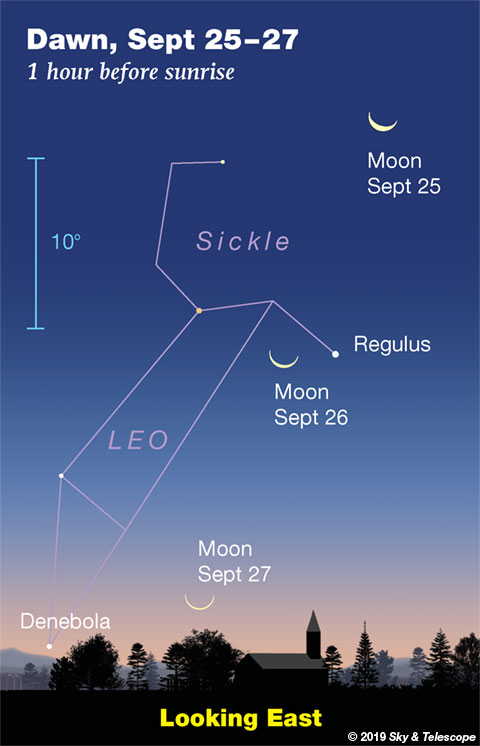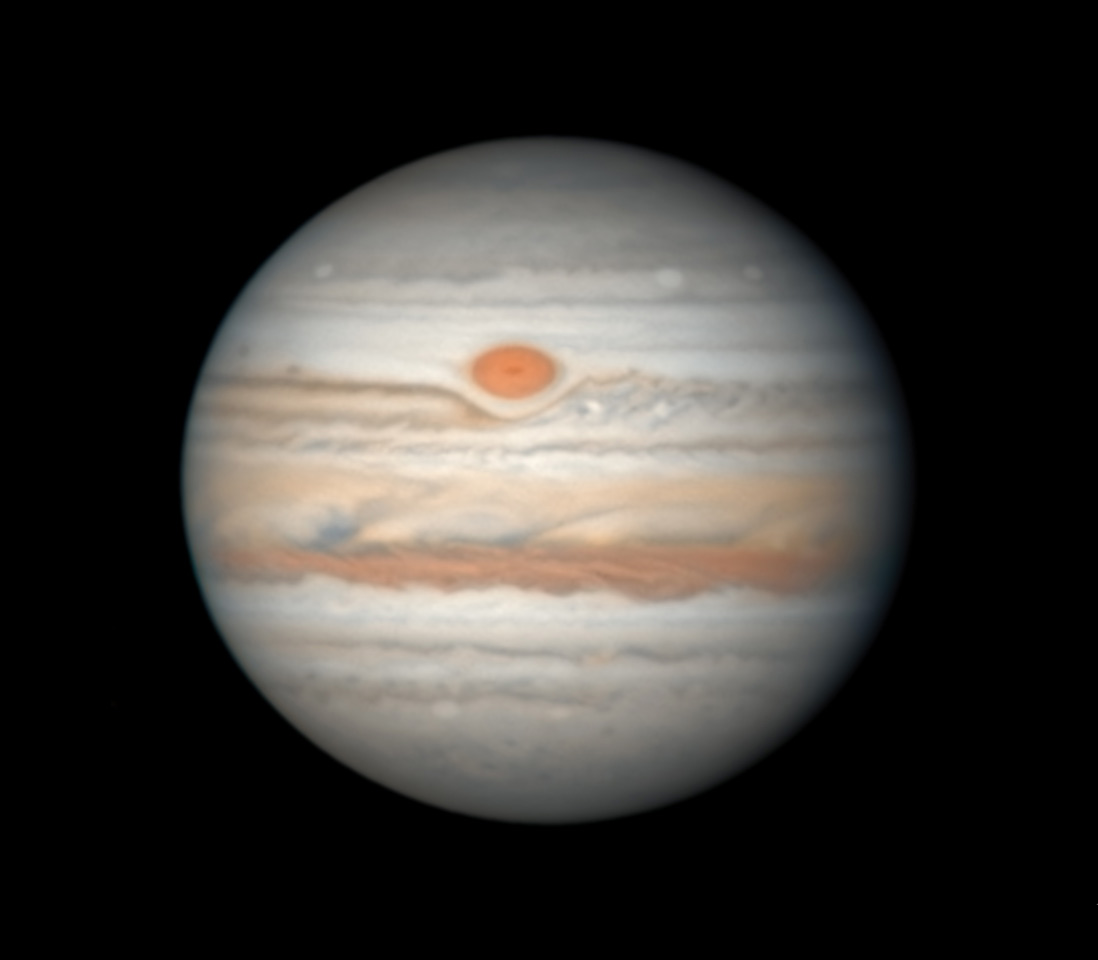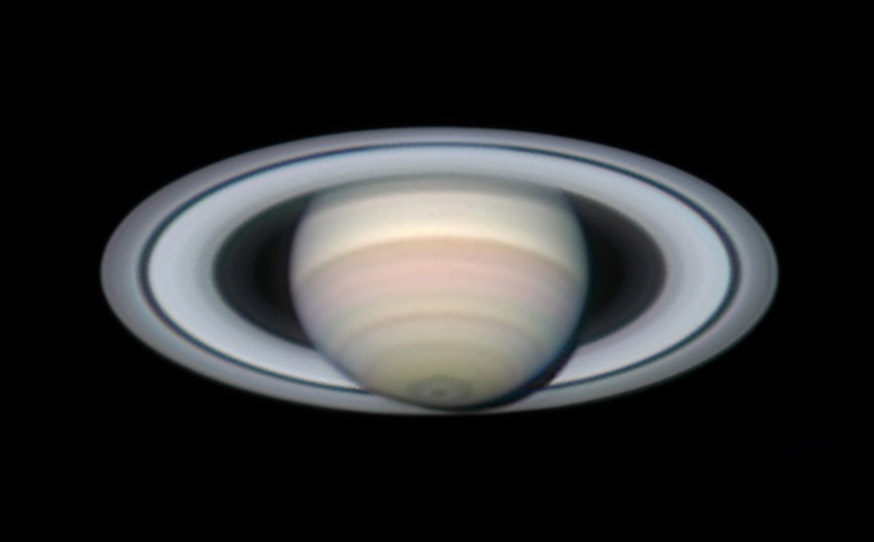
Friday, Sept. 20
• Cassiopeia displays its flattened-W shape high in the northeast these evenings. The W is tilted left. To the ancient Greeks Cassiopeia was a mythical African queen. Her husband Cepheus, dimmer and more sprawled out, is currently the next constellation to her upper right. Both lie along the winter Milky Way.
• In the center of Cepheus, these moonless evenings are a good time to bring out your binoculars or scope and try for the unusually small, compact open cluster NGC 7160 — as Matt Wedel tells in the September Sky & Telescope, page 43.
Saturday, Sept. 21
• Last-quarter Moon (exact at 10:41 p.m. Eastern Daylight Time). Tonight the Moon rises around midnight daylight-saving time, depending on your location. Watch for it to peek above the east-northeast horizon lower right of Capella and lower left of the Pleiades.
By the first sign of Sunday's dawn the Moon is shining high in the southeast, now with Orion to its lower right and Gemini to its lower left. How often do you examine the Moon with your telescope when the Moon is its late-night waning phases? To most of us, the waxing Moon of evening is much more familiar — when lunar mountains and crater walls cast their shadows in the opposite direction.
Sunday, Sept. 22
• Fall begins late tonight; the September equinox occurs at 3:50 a.m. September 23rd EDT. This is when the Sun crosses the equator (Earth's equator and therefore the celestial equator too), heading south for the season. Sunrise and sunset are very nearly 12 hours apart, and the Sun rises and sets practically at the east and west points on your horizon.
• Every year around when summer turns to autumn, Deneb takes over from brighter Vega as the zenith star after nightfall (for skywatchers at mid-northern latitudes).
Monday, Sept. 23
• "My favorite observations allow me to make comparisons," writes Matt Wedel in the October Sky & Telescope: "similar objects at different distances, or objects of different sizes at the same distance." For binocular observers he offers some examples at the bowl of the Sagittarius Teaspoon, which is currently just above the bright landmark Saturn. See his Binocular Highlight column on page 43 of the October issue.
Tuesday, Sept. 24
• In the west, off to left of the Big Dipper, bright Arcturus, the "Spring Star," shines a little lower at nightfall each week. From Arcturus, the narrow kite-shaped pattern of Bootes extends 24° to the upper right.
Wednesday, Sept. 25
• Before and during dawn on Thursday morning the 26th, look about 3° right of the crescent Moon for Regulus, as shown at the top of this page (for the middle of North America). Binoculars will help with Regulus as the sky begins to grow bright.
Thursday, Sept. 26
• At this time of year the rich Cygnus Milky Way crosses the zenith in early evening (for skywatchers at mid-northern latitudes). The Milky Way extends straight up from the southwest horizon, passes overhead, and runs straight down to the northeast.
Friday, Sept. 27
• Arcturus shines in the west as twilight fades out. Capella, equally bright, is barely rising in the north-northeast (depending on your latitude; the farther north you are the higher it will be.) They're both magnitude 0.
Later in the evening, Arcturus and Capella shine at the same height in their respective compass directions. When will this happen? That depends on both your latitude and longitude.
When it does, turn to look southwest. There will be Jupiter at about the same height (depending on your latitude).
Look south-southeast, and there will be 1st-magnitude Fomalhaut about equally high too.
Saturday, Sept. 28
• The starry W of Cassiopeia stands high in the northeast after dark. The right-hand side of the W, the brightest side, is tilted up.
Look along the second segment of the W counting down from the top. Notice the dim naked-eye stars along that segment (not counting its two ends). The brightest of these, on the right, is Eta Cassiopeiae, magnitude 3.4. It's a Sun-like star just 19 light-years away with an orange-dwarf companion, a lovely binary in a telescope.
The "one" on the left, fainter, is a naked-eye pair in a dark sky: Upsilon1 and Upsilon2 Cassiopeiae, 0.3° apart. They're orange giants unrelated to each other, 200 and 400 light-years away. Upsilon1, slightly fainter, is the farther one.
________________________
Want to become a better astronomer? Learn your way around the constellations. They're the key to locating everything fainter and deeper to hunt with binoculars or a telescope.
This is an outdoor nature hobby. For an easy-to-use constellation guide covering the whole evening sky, use the big monthly map in the center of each issue of Sky & Telescope, the essential guide to astronomy.

Once you get a telescope, to put it to good use you'll need a detailed, large-scale sky atlas (set of charts). The basic standard is the Pocket Sky Atlas (in either the original or Jumbo Edition), which shows stars to magnitude 7.6.
Next up is the larger and deeper Sky Atlas 2000.0, plotting stars to magnitude 8.5; nearly three times as many. The next up, once you know your way around, are the even larger Interstellarum atlas (stars to magnitude 9.5) and Uranometria 2000.0 (stars to magnitude 9.75). And read how to use sky charts with a telescope.
You'll also want a good deep-sky guidebook, such as Sue French's Deep-Sky Wonders collection (which includes its own charts), Sky Atlas 2000.0 Companion by Strong and Sinnott, or the bigger Night Sky Observer's Guide by Kepple and Sanner.
Can a computerized telescope replace charts? Not for beginners, I don't think, and not on mounts and tripods that are less than top-quality mechanically (meaning heavy and expensive). And as Terence Dickinson and Alan Dyer say in their Backyard Astronomer's Guide, "A full appreciation of the universe cannot come without developing the skills to find things in the sky and understanding how the sky works. This knowledge comes only by spending time under the stars with star maps in hand."
This Week's Planet Roundup

Jupiter (magnitude –2.1, between the feet of Ophiuchus) is the white dot low in the south-southwest as twilight fades away. Orange Antares, much fainter at magnitude +1.0, twinkles 9° to its lower right. It's a poor season for Jupiter telescopically. Not only is the low-altitude seeing a mess, but Jupiter has shrunk to just 37 arcseconds wide.

Saturn (magnitude +0.4, in Sagittarius) is the steady yellow "star" in the south during and just after dusk. It's 27° upper left of Jupiter. Below Saturn is the handle of the Sagittarius Teapot. Barely above it is the dimmer, smaller bowl of the Teaspoon.
Uranus (magnitude 5.7, in Aries) is well up in the east by 10 or 11 p.m. daylight saving time and highest in the south around 2 or 3 a.m.
Neptune (magnitude 7.8, in Aquarius) is well up in the southeast by 9 or 10 p.m. and highest in the south around 11 or midnight. See Bob King's article on observing Neptune and our finder charts for Uranus and Neptune.
All descriptions that relate to your horizon — including the words up, down, right, and left — are written for the world's mid-northern latitudes. Descriptions that also depend on longitude (mainly Moon positions) are for North America.
Eastern Daylight Time (EDT) is Universal Time (UT, UTC, GMT, or Z time) minus 4 hours.
Audio sky tour. Out under the evening sky with your earbuds in place, listen to Kelly Beatty's monthly podcast tour of the heavens above. It's free.
"The dangers of not thinking clearly are much greater now than ever before. It's not that there's something new in our way of thinking, it's that credulous and confused thinking can be much more lethal in ways it was never before."
— Carl Sagan, 1996
 0
0








Comments
You must be logged in to post a comment.